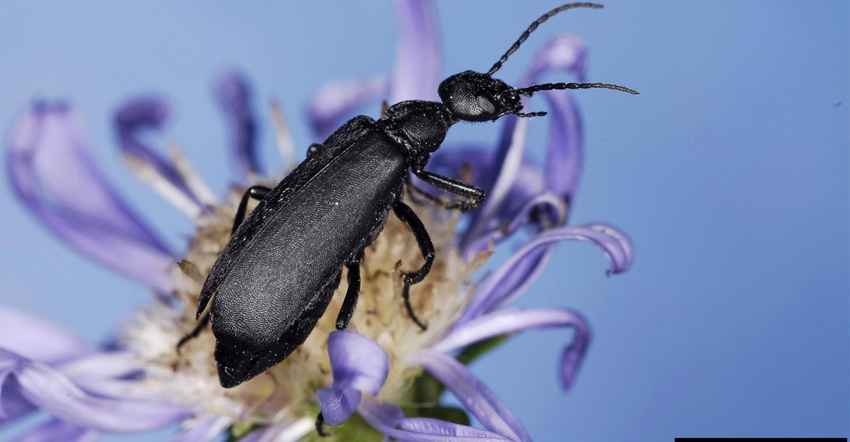
The headlines may have died down, but blister beetles remain a concern for farmers and ranchers. Blister beetles came onto the scene about a year ago as they were linked to the deaths of more than a dozen horses and sickening an additional 100 on a Wisconsin farm.
“That was a wake-up call for a lot of people, especially here in South Dakota,” says Patrick Wagner, entomology field specialist at South Dakota State University’s West River Research and Extension Center in Rapid City.
These beetles come in a variety of colors but are typically gray, black or striped. They are attracted to blossoms and pollen, thus often finding homes in alfalfa fields. The Wisconsin horses died or fell ill when they ate out-of-state hay, which came with a side of blister beetles, which when crushed emit a blister-causing chemical called cantharidin.
Wagner shares data from studies showing that 1 milligram of cantharidin per 2.2 pounds of body mass can be lethal for horses. Each adult blister beetle may contain 1 to 5 mg of the toxin, with the striped species averaging about 5 mg and the ash-gray species averaging 1 mg.
For perspective, Wagner shares data showing a 500-pound horse must eat 1,100 of the black blister beetle species, while only 80 of the three-striped species can prove lethal to that same horse. “That’s why it’s important to know what species are out in the field, so you know how toxic that alfalfa might be,” he says, adding that horses are more susceptible to cantharidin than cattle.
There are five common species in South Dakota, which range from 2/5 to 1 inch long:
black
ash gray
immaculate
striped
margined
Wagner adds that the margined blister beetle “can cause some considerable defoliation, not enough to worry about for alfalfa growers, but if you’re a gardener, they may cause some damage.”
When to scout
Though Wagner suggests scouting for these beetles prior to each cutting, he admits that higher infestations are more likely for the second and later cuttings. Blister beetles are predatory, feeding on grasshopper eggs, so the presence of grasshoppers one year may be a tip-off to where to scout the following year.
Sweep nets are useful in scouting for blister beetle infestations, being able to capture insects that may escape detection otherwise. Wagner says no economic thresholds have been established, as it depends on which species are present. He encourages producers to wear gloves and practice caution when scouting, as contact with cantharidin can cause blisters, as the beetle’s name implies.
Beetle management
Since the beetles are attracted to blossoms and pollen, Wagner suggests attempting to harvest the alfalfa before peak bloom. “If they are already out there, you want to cut the hay without using a conditioner,” he says. “You don’t want to crimp it or crush it because it can smash those beetles, and even if they’re smashed, that cantharidin will just coat the alfalfa, and that’s not a good thing.”
If there is a high beetle infestation, Wagner also suggests allowing hay to dry before raking it, allowing those beetles time to vacate the cutting before it is baled.
Wagner advises against spraying an insecticide to kill the blister beetles, because dead or alive, they still contain cantharidin. Also, rather than allowing the beetles to flee the scene, killing them in place will potentially make for a larger number of beetles found in each bale.
Post-bale management
Farmers looking to sell hay should inform the buyer of a blister beetle infestation. Wagner suggests using only the first hay cutting for horses since the risk of beetle presence is lower in that first cutting.
Acknowledging there may be an “edge effect,” Wagner says horse owners should avoid feeding hay from the edges of fields. “Though they might not be out in the middle of the field, the borders often have higher populations of these insects.”
To find more information about managing blister beetles, check out the SDSU Extension.
About the Author(s)
You May Also Like






